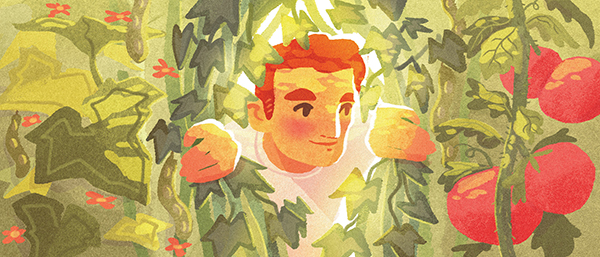Illustration by Jameela Wahlgren
Keeping Our Connection to Sun and Seed
by Ryan Kuck
Every year come tax time I have to pause for a long while when the 1040 asks for my occupation. At first the mild rebellion of writing “urban farmer” was alluring, imagining that someone in some deep office had to scratch their head to figure out what category that fits under. Then I imagined them looking at my paltry income for the year and giving a knowing chuckle. “Idealist,” “Young’un,” “Liberal,” “Fool.” But, hey, at least I could get my taxes done in 12 minutes.
This wasn’t supposed to be my path. I was well on my way toward being (or more likely interning for) the next Frank Lloyd Wright or Robert R. Taylor. But the ephemeral nature of Penn’s architecture program, with its abstract analysis through wooden models, lack of even basic computer training and—ugh—insistence on art history, didn’t grab hold. One day I saw a flyer on campus inviting anyone to “come plant carrots with kids,” and before I knew it I stopped going to class and had a new career.
I just did my taxes last night. Now it takes 20 minutes (kids complicate everything), and that pause was longer this time around.
In 2017, as the new executive director of Greensgrow Farms, I sit at a desk most days, or rather, pace anxiously around my desk. Can I still write “urban farmer” if I haven’t touched soil in over a week? Aren’t there some rules around this? The last few years, for sure, I spent more time with a hammer in my hand than a shovel, but at least I was still getting my vitamin D from the sun instead of a bottle, and I still had to scrape my boots on the muck board outside my door.
Greensgrow celebrates its 20th anniversary this spring, and naturally we’re thinking about what the next 20 years will bring. Sometimes it’s hard to look beyond, “Well, the cherry harvest is probably gonna suck this year after that cold snap.”
I am no more prescient than the next upstart know-it-all to say what the future holds. I am, though, encouraged to see new models for food production emerging that further integrate agriculture in our cities. Sometimes the cynic in me wins out when terms like “agrihood” are thrown around the interwebs as if someone invented the next tractor.
Agriculture has always been central to community, and places like Las Parcelas in Norris Square and Glenwood Green Acres in North Philly have been agrihoods for decades. So, yes, this is the future of urban agriculture, because it is also its past. The same can be said for “vertical farming” or “aeroponics” or the countless other inventions that promise to change how we feed our growing cities. Sometimes it’s easy to see these projects as false prophets, when there’s no math in the world that says we won’t still need Lancaster County and South Jersey and California to fill our bellies—you know, the folks who write just “farmer” on their taxes. I’m sorry, but we all can’t eat just lettuce. But these things, too, will play a role in farming’s evolution, just as irrigation technology has always driven adaptation.
In many ways farming is always the same, no matter the context or the technology. Farming is also an innovation laboratory. And the farmer has always needed to be an inventor (and a plumber, vet, mechanic, huckster and geneticist). In my relatively short career, I’ve made biodiesel, built birdhouses, scrubbed algae, taught social studies, cozied up to politicians and put a pig on a diet all in the name of urban agriculture.
But you are always fighting invisible forces of climate, genetics, soil, sun, sweat—learning to give in to the biological imperative of the seed—becoming accustomed to failure and still somehow being surprised by success.
As cities grow and as we look to keep urban agriculture relevant, the farm has to keep adapting, keep incorporating new roles and, above all, prioritize accessibility. We need city planners, musicians, chemists, math teachers—even architects—to all find a place on the farm so that it can continue to integrate with our built environment and so our cities don’t lose that connection to nature and to seed.
This all requires continued advocacy and action to ensure that green space remains available to farmers, and that farms find new collaborations. We must insist on our equal rights to land, on par with housing, hospitals and commerce. Or, to quote Greensgrow’s new vision statement, “ensure that urban agriculture is recognized as an essential element of how cities promote equitable economic opportunity, positive health outcomes and ecological stewardship for all.”
I can tell you what I hope the future of urban agriculture is. I hope that it is rooted in sun and soil. I hope we recognize that access to growing space is essential to the success of our neighborhoods. I hope we all can come to call ourselves urban farmers to some degree. And I hope that the suit in the IRS building nods in appreciation when my “urban farmer” tax form crosses her desk—and that it’s not the only one.
Ryan Kuck is an urban farmer and the executive director of Greensgrow Farms.



